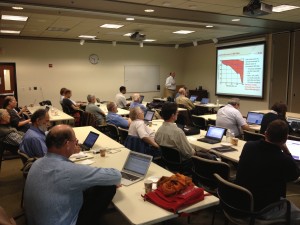
The members of SiD detector concept are taking steps to become a fully established collaboration. Image: Jim Brau
The SiD detector concept held a workshop at SLAC from 14 to 16 October. This was the first workshop held since the completion of the Detailed Baseline Design document and was an opportunity to consider the next steps in detector development and organisation of the concept. The workshop agenda can be found here.
The next phase for SiD will be known as the “SiD Consortium”. It is intended to be a step towards an eventual full collaboration to construct and operate the SiD detector at the ILC. The SiD Consortium has two spokespersons, an Executive Committee, and an Institute Board and will benefit from the appointment of several key individuals. The Institute Board is chaired by Phil Burrows from Oxford University; Jim Brau (U. Oregon) serves as R&D Coordinator, and Martin Breidenbach (SLAC) is the Technical Coordinator. The Consortium has adopted a set of bylaws to guide its work. It was emphasised during the workshop that the SiD Consortium is open to any institute or individual who is interested in SiD and would like to contribute to its development. To apply for membership, please send an email to the Institute Board Chair, Phil Burrows.
At the workshop news from Japan was given by the LCC Associate Director for Physics and Detectors, Hitoshi Yamamoto. He gave details of the ILC site selection and discussed the recent statement by the Japanese Science Council concerning the ILC. The results of the Snowmass Community Study were presented by Michael Peskin from SLAC with his interpretation of the ILC moving forward. “The statement that the ILC physics case is very strong has been accepted by the Snowmass study,” his summary slide stated.
The second day of the workshop consisted of presentations of the latest R&D results with a focus on calorimetry. The first results from a beam test of a prototype silicon-tungsten electromagnetic calorimeter were presented, along with updates on the development of RPC-based digital hadron calorimetry and scintillator-based analog hadron calorimetry. Additional topics included the Chronopix vertex detector chip, forward calorimetry, pixel developments in the UK, and the gain stabilisation of silicon photomultipliers. On the final day of the meeting the current status of the Machine-Detector-Interface was reviewed by Marco Oriunno, also in-light of the site decision. Martin Breidenbach summarised the additional R&D, detector optimisation, and resources needed to write a “real” Technical Design Report for SiD, setting the scale of the work that will be required.
The next steps for SiD, possible detector optimisation, and further benchmarking were summarised by Andy White in his close-out talk. The meeting ended with a lively Spokesperson Question Time, with questions such as “How do we keep the momentum of SiD while we wait for an official announcement from Japan?” The answer: we study detector optimisation, recruit more collaborators, and argue for a detector part of an ILC budget in the U.S. and discussion about ILC political developments.


Recent Comments